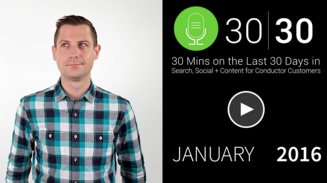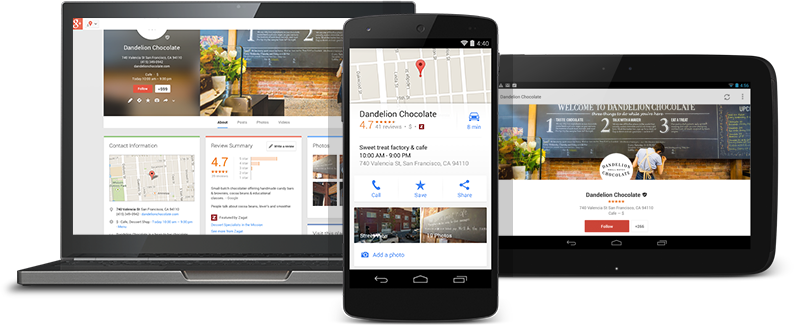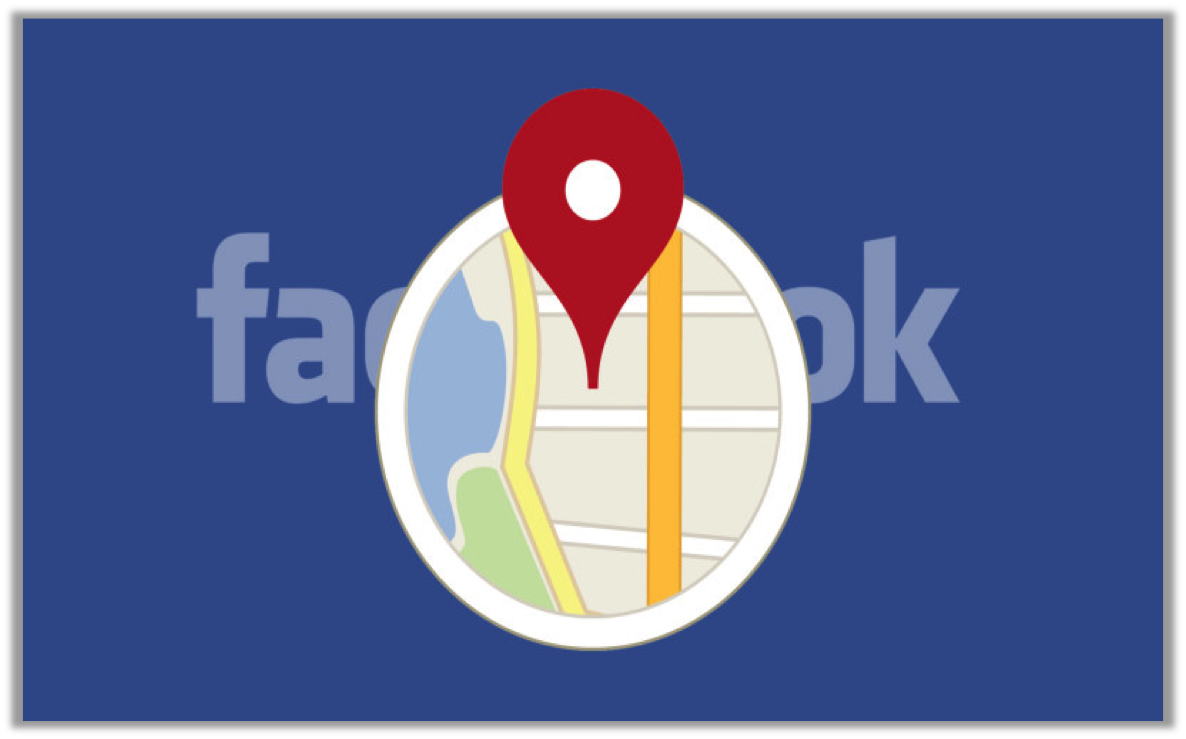SEO Industry News: Google's Core Algorithm Update, Google Panda, My Business
In our January 2016 edition of Conductor 30|30 (which is 30 minutes on the last 30 days in search, social, and content), Pat Reinhart starts off the year discussing big changes in marketing. Click a topic below to jump down:
- Google's Core Algorithm Update
- Google Panda Assimilation
- Accelerated Mobile Pages (AMP)
- Google My Business API
- Facebook Professional Services
We also had a ton of unanswered Q&A questions during the webinar. Click a question below to jump down:
- Can you define “real-time”? What is the main difference between a “Real Time Algorithm” and Google's current algorithm today?
- What are some things to focus on as we get closer to a potentialGoogle Penguin assimilation to the core algorithm?
- What should I do tomorrow to optimize my content with these new algorithm changes?
- You stated in the webinar that My Business won't affect rankings. But will Google My Business affect the local search results at the top of the SERP?
- With the Accelerated Mobile Pages (AMP) becoming the new standard, will there be a need for a specific kind of optimization for these pages? How will AMPs be prioritized?
- Is AMP eventually meant for mobile advertising in your opinion?
- Will the return of Matt Cutts signal RankBrain going rogue and bring the rise of a robot resistance?

Want more details? Get into the nitty-gritty by watching the full webinar recording for January's edition.
1. Core Algorithm Updated Over the Weekend
Google has actually announced that there was a major core algorithm update over the second weekend of January 2016, similar to the quality update they released in May 2015). Usually they update their algorithm quietly but since Google knows their algorithm is getting better, they may be avoiding their typical phantom updates (release without public confirmation).
This algorithm change is not to be confused with the Panda assimilation below. This is a completely independent update to their core algorithm to improve its real-time efficiency.
2. Google Panda Assimilation
The second major algorithm announcement is that Google Panda is now part of the core algorithm. So to reiterate, Panda was not updated, it was simply assimilated into the main algorithm. This is what Google's PR Team had to say about it:
“Panda is an algorithm that's applied to sites overall and has become one of our core ranking signals. It measures the quality of a site, which you can read more about in our guidelines. Panda allows Google to take quality into account and adjust ranking accordingly.”
What does this mean for you? Google is happy with its Panda implementation enough to make it permanent. If you were positively affected by Panda in your rankings, keep up the great work. If negatively affected, you should bring your website up to par with the Google Website Guidelines to start mending the damage.
3. Google Rolling Out Accelerated Mobile Pages To Everyone Next Month
After a successful testing period, Google has announced that they are going to be rolling out their accelerated mobile pages to everyone in February of 2016. AMP pages, as discussed in our November 30|30 recap, were previously exclusive to certain publishers. Now AMP pages will be available to everyone. Find out how here.
4. Google My Business API Has Launched
Google had officially launched the API for Google My Business. This is great way to manage branches and locations for businesses so that “customers can find you, no matter what device they're using.”

This API will be a much easier way for companies to create and edit their listings' information, especially for companies with thousands of locations.
Google My Business API includes:
- Create business locations with information such as name, address, phone number, category, business hours, and more
- Manage special hours
- Mark a business location as permanently closed
- Manage business photos
- List, invite and remove managers on locations and business accounts
- Read listing state to identify Google updated, duplicate and suspended locations
- Search/Filter locations by name, category and label
- Set the service area for a business either by specifying a point and radius or Place IDs
You can find the full API documentation here.
5. Facebook Professional Services
Facebook now has an area on their site dedicated to professional services. This feature is very similar to Yelp where it helps you find the highest rated business in a given area.

There are currently 85 business categories you can choose from when you create your listing. The business will show up in Facebook's business search results based on the five-star rating system that is currently implemented.
But, it looks like there are other metrics that have influence in rankings. It will be very interesting to see how much Facebook promotes this, if at all, and tries to aggressively move into this space.
Pat Reinhart Answers Your Webinar Questions
Q1. Can you define “real-time”? What is the main difference between a “Real Time Algorithm” and Google's current algorithm today?
The main difference is that a real-time algorithm would not need manual data pushes to update, but rather, they would updated automatically second to second, minute to minute, hour to hour. Currently all algorithm updates require manual data pushes. While Google's core algorithm technically does work and process data in real time, to update it they still need to push manual data.
Q2. What are some things to focus on as we get closer to a potential Penguin assimilation to the core algorithm?
You should always keep an eye on your link profile and audit it quarterly to ensure there is nothing harmful going on. For larger brands this is more of a challenge, but also less of a concern as they tend to have a higher volume of quality links than smaller brands. Regardless of the size of your business, you should make the investment to monitor your backlink profile on a regular basis.
Q3. What should I do tomorrow to optimize my content with these new algorithm changes?
You may also like…
You wouldn't necessarily “do” anything to optimize your site different for this specific change, but rather, you should be looking at your SEO program as a whole and see where the holes are that caused the site to remain flat, or worse, fall in the rankings. Create great content, do it often, optimize it, work with partners to share content and build quality links. These are all things that you can do tomorrow, and should always be doing.
Continue to evolve with the algorithm and make sure your program doesn't get stagnant. Make your paid team speak with your SEO team, integrate campaigns and share ideas. That's what the most successful campaigns usually draw their strength from.
Q4. You stated in the webinar that My Business won't affect rankings. But will Google My Business affect the local search results at the top of the SERP?
Google My Business listings don't necessarily affect your overall site rankings (I don't think at all, but there are hundreds of unknown ranking factors so I guess it's possible), but are the properties that you need to update and maintain to show up higher in local search.
Best practices here are to ensure your NAP information (Name, Address, Phone Number) is consistent across as many local aggregators as possible, not just GMB. Don't try to optimize your listing, just put the correct information, and then work on making that information correct across the web. MozLocal is a great way to see how you are doing across multiple properties, but there are other companies that help you do this such as WhiteSpark and Yext.
Q5. With Accelerated Mobile Pages (AMP) becoming the new standard, will there be a need for a specific kind of optimization for these pages? How will AMPs be prioritized?
I want to be clear here that AMP pages becoming standard is a prediction of mine, and not necessarily what the state of the web is at this time.
There is a very specific way you need to code these types of pages, which is described at www.ampproject.org, but the main thing to know is that these are completely separate pages that should be created and then canonicaled back to the live page, and are not meant to be indexed. This isn't a ranking play, it's a visibility play within the AMP carousel that will appear for certain terms. Learn more at the URL provided.
Q6. Is AMP eventually meant for mobile advertising in your opinion?
This is a truly great question and I believe there are two ways to look at it. AMP, at the moment, is going to be mostly used by publishers to get their content to their users faster and without any load times. From an advertising perspective, my guess is that dynamic ads, such as Google AdSense, will not function properly within this framework and most likely will cause tracking issues with many platforms that measure the eyeballs viewing an ad.
With that said, Google is a sales organization and I can't imagine their plan is to do this out of the goodness of their own hearts and eventually will work out a way that the advertising will be available and trackable. This could already be in place, as I said, this is a very new technology that only a few companies have been given access to, so time will tell.
Check in at www.ampproject.org for more info.
Q7. Will the return of Matt Cutts signal RankBrain going rogue and bring the rise of a robot resistance?
It's truly too soon to tell what the re-emergence of Cuttsman would bring back to the table, for all we know he IS Rankbrain and we could be on the cusp of a full-on Lawnmower man situation. I guess all we can do is wait and see if our phones all ring in unison.

 SEO News: App Interstitials, Facebook Reactions, Panda Update 4.2 - Conductor 30/30
SEO News: App Interstitials, Facebook Reactions, Panda Update 4.2 - Conductor 30/30 SEO News: Accelerated Mobile Pages, RankBrain, the Next Penguin Update - Conductor 30|30
SEO News: Accelerated Mobile Pages, RankBrain, the Next Penguin Update - Conductor 30|30